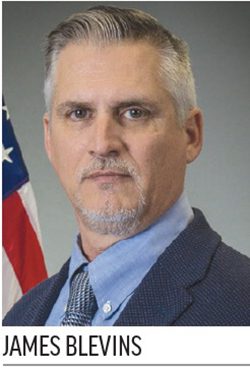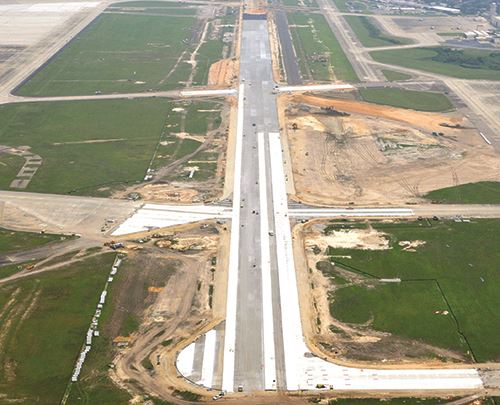Previously known as Pope Air Force Base, POB is part of the Fort Bragg garrison. Its lead Air Force tenant unit is the 43rd Air Mobility Operations Group, which is responsible for rapid strategic deployment of forces assigned to the Joint Special Operations Command and the U.S. Army’s XVIII Airborne Corps and 82nd Airborne Division.
By any measure, 120 days is an aggressive schedule for sizable construction, and even more so when it’s an airport project. Pope Army Airfield (POB) in North Carolina managed to replace all the pavement on its 9,501-foot runway and upgrade lighting throughout the airfield between June 15 and Oct. 13, 2021.
Previously known as Pope Air Force Base, POB is part of the Fort Bragg garrison. Its lead Air Force tenant unit is the 43rd Air Mobility Operations Group, which is responsible for rapid strategic deployment of forces assigned to the Joint Special Operations Command and the U.S. Army’s XVIII Airborne Corps and 82nd Airborne Division. From April 2020 through March 2021, POB logged 24,471 operations. Without the restrictions posed by COVID, annual operations are usually closer to 33,000.
The airport’s single runway, 5-23, has an asphalt midsection with concrete overruns. Every 10 to 15 years, the critical airfield is shut down for about two months while crews replace the runway asphalt. When this happens, training operations and units based there need to be temporarily relocated. Given the associated costs, minimizing airfield closure time is always a priority.
|
facts&figures Project: Runway Reconstruction Location: Pope Army Airfield in Northw Carolina Runway: 5-23 Associated Elements: Apron & taxiway reconstruction; new airfield lighting Notice to Proceed: Late 2020 Construction: June 15-Oct. 12, 2021 Cost: $82 million General Contractor Joint Venture: RC Construction; Millstone Webber Electrical Contractor: Atlantic Electric Airfield & Runway Lighting: ADB SAFEGATE; Musco Labor Hours: 184,000 Concrete Poured: 91,000 cubic yards Stabilized Subgrade: 70,666 cubic yards Conduit Installed: 300,000 linear ft. |
The last time the asphalt was due for replacement, spring 2020, the decision was made to replace the entire runway with concrete rather than mill the surface, repave with asphalt and reset the clock for another 10 to 15 years. “I’d rather have a concrete runway because you can easily get 40 years out of it,” explains James Blevins, airfield manager at POB.
The increased cost of concrete made sense when balanced against all the costs associated with temporarily relocating units and training flights. It was also determined that the project could be completed within a 120-day closure. “In the long run, that eliminates all the shut downs we would have had to redo the asphalt,” reasons Blevins.
Marcia Meekins, Fort Bragg area engineer with the Army Corps of Engineers, notes that the 120-day closure was based solely on the pavement work—and the minimum time needed to remove the old runway material and replace it with new concrete, plus adequate curing time. “Everyone knew the paving was the longest pole in the tent,” says Meekins.
Phase Zero
Design and planning for the $82 million project took roughly eight months, and the Notice to Proceed was issued at the end of 2020. Planners divided the project into four phases, and in retrospect, participants agree that Phase Zero (pre-construction logistics) was the most important one of all. “It’s really what got us ahead of the game,” Blevins says.
“The upfront planning phase was critical,” emphasizes Meekins.
Phase Zero was when the equipment and materials needed for the project were assembled and stockpiled on site at POB and Fort Bragg. The inventory included rock, sand, operational batch plants, lighting, conduit and heavy machinery. “If we didn’t have that already in place, we wouldn’t have made the schedule at all,” Blevins advises. “As soon as we dropped the flag to shut down the airfield, crews were out there.”
Luke Beach, project manager for RC Construction, notes that it was essential to stockpile all the raw materials needed to produce the concrete before the runway closure began.
 “It really helped that we were able to do the pre-staging of all the material and have everything standing by, especially with such a short timeline,” Blevins says. “If we couldn’t have done that, there was no way we would have met the deadline.”
“It really helped that we were able to do the pre-staging of all the material and have everything standing by, especially with such a short timeline,” Blevins says. “If we couldn’t have done that, there was no way we would have met the deadline.”
Having materials and equipment onsite in advance also kept the roadways free of construction traffic throughout the process, Beach adds. Paving operations were completed overnight during the 24/7 operation, which reduced congestion at the worksite and around the airport.
The project team installed gates strategically on opposite ends of the airfield to allow direct access to the work site and facilitate orderly traffic. A gate was also installed near the vault on the southwest side of the airfield to create access for lighting crews.
During Phase Zero, contractors set up the batch plant and secured approval for the concrete mix that would be used to repave the runway. Meekins and Beach both note that achieving the right mix was a challenging feat.
 The pavement mix is comprised of four aggregate sizes, but limited space at the job site meant there was not room for four different storage areas. “We have 17 acres where we were putting two batch plants and humungous stockpiles, and we really didn’t have room for four bins,” Meekins explains. Instead, the contractor pre-blended the two smallest aggregates and then checked the gradations throughout the day, every day, to ensure technical consistency. “The decision to blend the aggregates was critical because that allowed the batching to occur quicker since they were only loading three bins,” she adds.
The pavement mix is comprised of four aggregate sizes, but limited space at the job site meant there was not room for four different storage areas. “We have 17 acres where we were putting two batch plants and humungous stockpiles, and we really didn’t have room for four bins,” Meekins explains. Instead, the contractor pre-blended the two smallest aggregates and then checked the gradations throughout the day, every day, to ensure technical consistency. “The decision to blend the aggregates was critical because that allowed the batching to occur quicker since they were only loading three bins,” she adds.
120 Days and Counting
On June 15, 2021—Day 1 of the closure—crews began demolishing existing pavement on the south end of the runway and worked their way north. Overall, it took about two weeks to remove the old runway. Concrete was broken up and crushed for recycling and reuse; asphalt was milled and removed.
When one team completed its work, the next followed closely behind. Various crews moved through the job site like a steady train, with equipment rolling in via the south access gate and exiting to the north. “That provided a good flow to keep all the traffic and people headed in the same direction,” notes Matt Alwart, project manager with Millstone Weber.
 After demolition workers broke up the existing concrete and milled off the asphalt, other crews cut and graded the ground before a cement-treated base was applied. Seth Mailman, project manager at RC Construction, estimates that about 20,000 cubic yards of dirt was cut and removed to accommodate the new pavement.
After demolition workers broke up the existing concrete and milled off the asphalt, other crews cut and graded the ground before a cement-treated base was applied. Seth Mailman, project manager at RC Construction, estimates that about 20,000 cubic yards of dirt was cut and removed to accommodate the new pavement.
The entire runway surface was cement-treated with a slurry that was pre-mixed at an offsite plant, and then hauled to the airfield, where crews injected and tilled it into the ground—as opposed to broadcasting a dried cement. “So we were basically weather-proof from the point we got the dirt work done,” explains Alwart. “Then, we could work in any weather conditions.”
Mailman describes slurry injection as cleaner than traditional cement stabilization. “It provided an exceptionally stable platform within 24 hours for us to work off of,” he explains.
To prepare for a future project that will replace asphalt on taxiways with concrete, the airport extended the recent runway paving about 40 feet beyond the VFR hold line. Blevins notes that this preplanning helps ensure that POB will not have to shut down Runway 5-23 during the upcoming taxiway pavement work, which is currently in the design phase.

Improved Lighting
On the electrical side, the airport upgraded its airfield lighting with LEDs—runway edge lights, runway threshold lights, sequenced flashing approach lighting, airfield signage, taxiway lights, apron lighting and precision approach path indicators. The comprehensive lighting overhaul required 300,000 linear feet of new conduit.
The airfield’s new ALSF-1 approach lighting system uses LED lighting for all of the steady burning lights. This system has not been used by the FAA for commercial airports in the U.S. as it is still being evaluated by the FAA Technical Center. The U.S. military, however, has seen the advantages of the technology and is starting to incorporate it into plans.
 Andrew Fender, project manager with Atlantic Electric, notes that this made the installation challenging because crews had to incorporate the new lighting technology with existing hardware. With the installation successfully complete, he predicts that other airports will take note of the advanced system.
Andrew Fender, project manager with Atlantic Electric, notes that this made the installation challenging because crews had to incorporate the new lighting technology with existing hardware. With the installation successfully complete, he predicts that other airports will take note of the advanced system.
 “This is a nice example that the FAA can reference for use of LED approach lights at an airport,” says Galen Dixon of ADB SAFEGATE, adding that the new technology is expected to reduce energy and maintenance costs. Because some of the electrical and lighting upgrades needed to occur during the pavement installation, initial paving was concentrated to the very outside of the runway and taxiways.
“This is a nice example that the FAA can reference for use of LED approach lights at an airport,” says Galen Dixon of ADB SAFEGATE, adding that the new technology is expected to reduce energy and maintenance costs. Because some of the electrical and lighting upgrades needed to occur during the pavement installation, initial paving was concentrated to the very outside of the runway and taxiways.
Echoing a familiar theme, Fender says preplanning was critical to the electrical upgrades and provided breathing room in the aggressive schedule. “Our main challenge was figuring out the work we could do outside of the outage timeframe,” he recalls. “We developed and quickly mobilized pre-fabrication of both pre-case structures and the duct bank to do as much work beforehand as possible.” Large sections of the duct bank were installed before the runway closed, keeping it outside the runway safety area. Completing that and other electrical work before the closure also allowed Atlantic Electric to reduce its on-site crew size and simplified logistics, Fender notes.
Overcoming Obstacles
“With every project you’re going to have twists, turns and problems, and we had them,” Meekins reflects. “We overcame every one of them and finished on time.”
Subsurface surprises, like unmarked underground utilities, provided challenges, but the Fort Bragg utility locators were on the airfield daily to help keep the project moving forward.

 In addition to procuring and delivering all the needed materials and equipment ahead of time, the project team had to position everything on the airfield in the most efficient manner and order. “It was a giant resourcing and logistical hurdle to get all of that onto the Post,” Beach advises.
In addition to procuring and delivering all the needed materials and equipment ahead of time, the project team had to position everything on the airfield in the most efficient manner and order. “It was a giant resourcing and logistical hurdle to get all of that onto the Post,” Beach advises.
Originally, the project team was going to place temporary pavement markings to meet the tight 120-day timeline. However, that meant the runway would not have been certified for IFR conditions, which was a non-negotiable item for the leadership at Fort Bragg. Within the last 10 days of the project, the team pivoted and was able to apply 103,000 square feet of permanent retroreflective paint, allowing the airfield to be IFR certified. “And it was raining part of those days,” Meekins adds.
Blevins credits the project team’s planning and execution for ensuring that the airfield was ready for all operations, including IFR, by the appointed deadline.
Other challenges included trucking shortages, a fire that caused a cement kiln to be taken out of service and a batch plant that was temporarily down because of worker illness. Even so, flexibility, constant communication and re-sequencing work within some phases kept the project on schedule, says Meekins.
Project participants agree that open and constant communication cannot be understated as essential components to the success of the project. Meekins describes the teamwork as a “perfect storm of all good things”— from leaders who were willing to make quick and necessary decisions to skilled and knowledgeable contractors.



